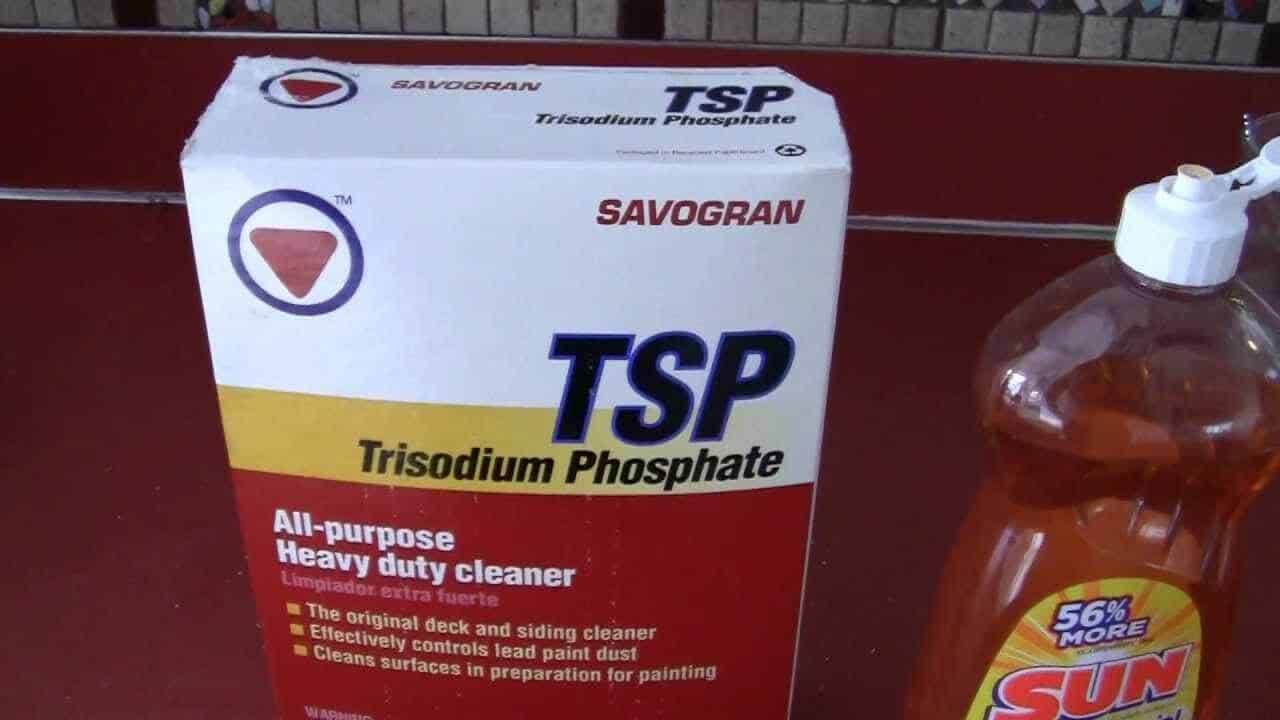Before we discuss cleaning with Trisodium Phosphate, you should know what TSP is all about!
What is TSP (Trisodium Phosphate)?
TSP, found in paint stores in containers marked as T.S.P. is touted as being an all-purpose cleaner.
TSP is an acronym for Trisodium Phosphate.
According to Wikipedia.com “The major use for trisodium phosphate is in cleaning agents. The pH of a 1% solution is 12, and the solution is sufficiently alkaline to saponify grease and oils.
In combination with surfactants, TSP is an excellent agent for cleaning everything from laundry to concrete driveways.
This versatility, coupled with lack of toxicity and low manufacturing price, made TSP the preferred basis for a plethora of cleaning products sold in the mid-20th century.”
Is TSP Safe To Use?

This is from the U.S. Dept of Health website:
Warnings: Keep away from children. Contact with tablet causes damage to eyes and skin. Harmful, if swallowed.
Avoid direct contact with a tablet. Do not use ammonia in a toilet bowl and do not add other household chemicals to toilet tank as hazardous gases may result.
- Acute Health Effects: From MSDS Inhalation Health Risks And Symptoms Of Exposure Small Amounts Of Dust Are Very Irritating. Large Exposures Can Cause Tissue Burns.
- Skin And Eye Contact Health Risks And Symptoms Of Exposure Eye Contact: Tissue Burns Are Likely. Skin Contact: Strong Irritant; Chemical Burns Are Possible. Skin Absorption Health Risks And Symptoms Of Exposure Not Known.
- Ingestion Health Risks And Symptoms Of Exposure Slightly Toxic (Due To High Ph)
- Health Hazards (Acute And Chronic) Acute: The Material Is Moderately Toxic To Humans. Inhalation Of Heavy Dust May Irritate Nose And Throat. Ingestion May Injure Mouth, Throat, And Gastrointestinal Tract. Contact With Eyes Produces Local Irritation And Possible Conjunctivitis.
- Chronic: Chronic Toxicity Is Known, But Is Not Believed To Be Significant For Low Concentration.
- Medical Conditions Generally Aggravated By Exposure: Skin Irritation May Be Aggravated In Persons With Existing Skin Lesions. Breathing Of Dust May Aggravate Acute Or Chronic Asthma And Other Chronic Pulmonary Disease.
- Chronic Health Effects: From MSDS Chronic Toxicity Is Known, But Is Not Believed To Be Significant For Low Concentration.
- Carcinogenicity: From MSDS Neither the NTP, IARC, nor OSHA lists trisodium phosphate as a carcinogen.
- If swallowed, do not induce vomiting. Call poison control or doctor immediately. If in eyes, rinse with clean warm water for at least five minutes. If on the skin, rinse with clean warm water until TSP is removed.
Will We Still Use It?
Yup. For preparing a surface for painting, it’s really useful. Care and concern must be exercised in its use, but use it we will.
I also know that there are “green” versions of TSP becoming more readily available, and I will switch as soon as I can find a source. I will keep using the “green” version when I find it, if it does as good a job as the regular form.
Here are tips on using TSP:
To clean a brush: Dissolve about two tablespoons of TSP in a gallon of warm water. Immerse brushes in this solution and leave for 24 hours. Remove the brushes, and wash them with warm soapy water. Repeat if necessary. A painting contractor told me that he drops his spray guns in this solution overnight, from time to time, to clean off the built-up paint that invariably gathers on this type of painting equipment.
To clean surface for painting: Dissolve about 6 tablespoons of TSP into a gallon of warm water. Saturate the surface to be painted, and scrub well. Rinse with clean, warm water until all traces of TSP are removed.
Clean cement floor: Dissolve 8 tablespoons of TSP in a gallon of warm-to-hot water. Scrub floor. For grease spots, sprinkle dry TSP on grease spots and add enough hot water to make a paste. Scrub aggressively, and then let stand for at least 30 minutes. Rinse with clean, warm water until all TSP is removed. Repeat as necessary on difficult cement-floor-grease stains.
Be Careful!!!
You need to know that if you leave a TSP residue on the surface, some products will either not stick, or will react negatively to the presence of that residue.
You must make sure that you rinse TSP completely off of any surface that you have cleaned with it, and you MUST READ the directions on every can of product that you are planning on using on that surface to see if they identify TSP as a problem.
A mistake in this regard might lead to more than a bad paint job. Be careful!
Got any cleaning tips you want to share? Any “secrets” that serve you well when cleaning up after a painting job? Let us know down in the comments section.
